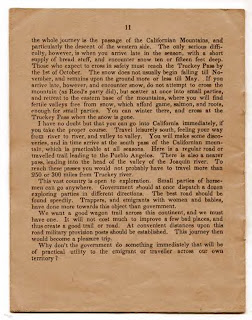Some say the American Westward Migration was from about 1837 to the mid 1840s with the Mormons going to Utah.
But for me, I believe the American Westward Migration started in 1804 with Lewis and Clark expedition exploring the Missouri River and the Oregon Territory, and ended in the 1890s when the Federal Government finally had control of all lands.
But for me, I believe the American Westward Migration started in 1804 with Lewis and Clark expedition exploring the Missouri River and the Oregon Territory, and ended in the 1890s when the Federal Government finally had control of all lands.
If you were going West to California to seek your fortune during the pioneer migration in the mid 1800s, you did have a few choices as to how to get there.
By ship you went all the way around the horn of South America and up the West coast until you were in San Francisco. It was a long hard trip. And even today, the trip around Cape Horn is not one that many want to take.
Of course there were wagon trains. The jump off point was St. Louis, Missouri. That's why St.Louis is still called "The Gateway to the West." From there you would have been able to choose whether to go to Independence or down to the southern route through Springfield and on into Indian Territory which is present day Oklahoma.
The trip by wagon train was not an easy trip either. This was a group of covered wagons, and usually around 100 or more wagons.
The wagons carried people and their supplies on their journey west. This was long before there were established stage lines or the transcontinental railroad was even thought of.
The wagons carried people and their supplies on their journey west. This was long before there were established stage lines or the transcontinental railroad was even thought of.
Since most of the country was not settled, it was difficult to travel. Mountain men first staked out the routes, but without the proper guides the trip could be confusing because of other trails made by Indians.
Wagon trains banned together to have strength in numbers because there was a real and present danger that that the wagon train would be attacked by Indians.
Wagon trains banned together to have strength in numbers because there was a real and present danger that that the wagon train would be attacked by Indians.
And yes, wagon trains were very well controlled and organized by those putting them together. You had to sign a contract to join, which meant that you subsequently agreed that you and your party would abide by the rules and regulations set forth by those in charge.
Each wagon train would choose one or two people to be in charge of military situations such as protection against Indians, and there would be someone in charge of keeping discipline and the peace within those traveling.
Along with everything else, there was a strict order for placement of the wagons on the trail and at the camp at night. Riding on the trails created a lot of dust.
All Cowboy who's moved cows during the summer know real well about picking up the rear and riding drag on a herd. It's no fun when all you're doing is eating dust as the cows move along. So the wagon trains would change their order of wagons to help people take turns bearing the worst of bad situation.
All Cowboy who's moved cows during the summer know real well about picking up the rear and riding drag on a herd. It's no fun when all you're doing is eating dust as the cows move along. So the wagon trains would change their order of wagons to help people take turns bearing the worst of bad situation.
 Wagon placement at night was extremely important as well, and yes wagons would make a circle.
Wagon placement at night was extremely important as well, and yes wagons would make a circle. They would form a circle with one opening to better guard against the Indian attacks, and it also kept all of the animals under control and stopped them from wandering off from the train.
It was also a standard procedure to take the lead wagon's tongue and point it in the direction where they are headed so that in the morning they knew what direction they needed to resume.
And if you have seen the old movie How The West Was Won, then you will remember the dance during the trip.
Well, fact is that there were many individuals who played musical instruments who came West with the wagon trains. And yes, they often entertained at night.
Well, fact is that there were many individuals who played musical instruments who came West with the wagon trains. And yes, they often entertained at night.
Years ago, I was sent these copies of a booklet that was printed in 1849 and circulated among those who were willing to make the trip West by wagon train.
This is the original booklet page by page. Its not that long actually, but you might find it interesting reading if you really want to know what they had to do, what supplies were needed, how they had to get ready, how they had to conduct themselves on the trail, and among other things what they were limited to taking with them.
I've read this a few times over the years that I've had this. I'm always amazed to find that I've missed something here and there from when I read it the first time.
I hope you find it as interesting as much as I do.
Story by Tom Correa















No comments:
Post a Comment